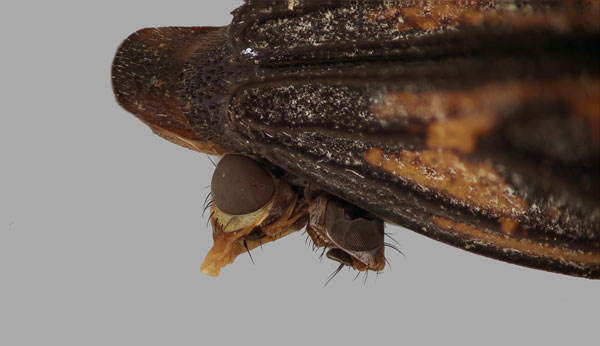The response to the jewel beetle field guide has been incredible thus far, with nearly 900 people requesting more than 1300 copies in less than 2 weeks! With all this attention to beetles around here lately, I figured I’d post a little reminder about which insect order still rules these parts.

Proof that 2 parasitic heads are more gruesome than 1. Parasitic flesh/satellite flies (Sarcophagidae) forever entombed as they attempt a late emergence from the abdomen of a captured Buprestis consularis jewel beetle. Photo by Adam Jewiss-Gaines.
We came across this little tragedy while examining and photographing specimens for the field guide, and Adam Jewiss-Gaines did a great job of bringing their sorry plight to life (so to speak) in this image-stacked photo.
I tried to track down what species (or even subfamily) these flies may be, but I couldn’t find any record (in my admittedly quick search) of sarcophagids using Buprestidae as hosts. According to the Manual of Nearctic Diptera Vol. 2, these little guys likely belong to the subfamily Miltogramminae (based on their seemingly bare arista), which are commonly known as satellite flies for their habit of orbiting ground nesting bees and wasps and kleptoparasitizing their collected prey, but I’m unsure whether they will parasitize free-living beetles. If they are in fact members of the Sarcophaginae (some of whom do have bare arista), perhaps these individuals are members of the genus Sarcophaga, species of which have been reared from beetles and various other insects.
Without being able to examine the rest of their bodies, I may never know what these flies are, but I find it fascinating that they matured and began their escape only to be killed and preserved within our collection!
While we’re talking about flesh flies, I want to call your attention to some absolutely amazing Scanning Electron Micrographs of male sarcophagid genitalia taken by my friend Dave Cheung. Not only are the genitalia bizarre and the micrographs beautiful, but Dave has worked his magic and made them both zoomable and rotatable, creating pseudo-3D models! Check them out — I guarantee they’ll blow your mind!
UPDATE Dec. 17, 2012: Never mind about this being a free-living beetle! I double checked the specimen label, and this beetle was actually collected from a Cerceris fumipennis colony in Highland Hammock State Park, Florida, which almost certainly makes these Miltogramminae satellite flies.
Information regarding Sarcophagidae biology was taken from SarcoWeb, a website created and maintained by Dr. Thomas Pape which is dedicated to the study of flesh fly taxonomy.

These flies emerging from a jewel beetle make me think of dogs hanging their heads out the car window http://t.co/2ByAGrQl @BioInFocus
Wanna see why flies trump beetles, and why 2 parasitic heads are more gruesome than 1? Of course you do! http://t.co/kH1gh145
Wanna see why flies trump beetles, and why 2 parasitic heads are more gruesome than 1? Of course you do! http://t.co/kH1gh145
RT @BioInFocus Wanna see why flies trump beetles, and why 2 parasitic heads are more gruesome than 1? Of course you do! http://t.co/B5r1XhmU
Saying one has their head up their ass can be insulting, but for this jewel beetle & its parasites, it's sort of true! http://t.co/kH1gh145